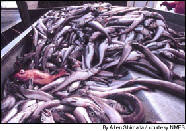|
Monday, February 19, 2001
By Gretel H. Schueller
A new fishing net may help keep ocean creatures such
as Dall's porpoises where they belong — safe at sea.
Most fishing gear isn’t discriminating when it comes to catching seafood. Plenty of unwanted fish and other marine life are unintentionally caught and killed every day.
Globally, the annual amount of such bycatch is more than 44 billion pounds. But there is some good news for porpoises and other victims of bycatch.
A clever fishing net may keep some animals from getting trapped and still let fishermen catch their target species. If the net works as well as tests indicate, the net has the potential to be quite useful, says researcher David Potter with the National Marine Fisheries Service. In fact, he says, it might turn out to be a global solution.
All along the eastern and western shores of North America, in Europe and many other areas of the world, fisheries use gillnets, which are designed to entangle fish by their gills. Generally about a mile long and about 15 feet deep, gillnets are devastatingly efficient, catching anything larger than the net’s mesh size, which ranges from a few inches to a little more than 20 inches. Underwater, the thin nylon is nearly invisible.
In addition to non-targeted fish, a variety of seabirds, sea turtles and several species of porpoises, dolphins and whales are trapped in gillnets. The echo-location systems of porpoises and other such sea creatures fail to detect the net’s thin nylon filaments because the sound waves pass right through the net.
As a result, about 80,000 cetaceans are unintentionally caught worldwide every year. A study of the 1996 California drift gillnet fishery found that for every 22 swordfish caught, one whale or dolphin was killed as bycatch.
The new net is designed to reflect sound waves, limiting the catch of non-targeted fish.
The new net, developed by Atlantic Gillnet of
Gloucester, Massachusetts, has a substance
— barium sulphate — added to the nylon that
reflects sound. The result is a net that looks and
feels like a normal gillnet except that it reflects
sound waves in ranges used by echo-locating
animals.
Since 1998, Edward Trippel, a research scientist with the Canadian Department of Fisheries and Oceans at St. Andrews Biological Station, has overseen experiments with the net in the Bay of Fundy, an area that has received much attention because of its large harbor porpoise bycatch. The results, says Trippel, “are almost too good to be true.”
The reflective nets were given to fishermen who normally use gillnets to catch cod and pollock. Their catches were compared with those from conventional nets. While the control nets consistently caught porpoises, the reflective nets remained porpoise-free. A tinted-blue version of the net has the added benefit of reducing the numbers of seabirds caught, according to Trippel.
The reflective net is also being tested in Danish waters with equally successful results.
Courtesy Environmental News Network
|

